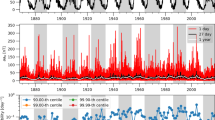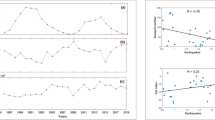Abstract
Prediction of Hawaiian volcanic eruptions depends primarily on the interpretation of records of earthquakes and tumescence of the volcano. Recent work byJ. P. Eaton of the U. S. Geological Survey appears to demonstrate the presence of two distinct groups of earthquakes. One group originates at a depth of 40 to 60 km, within the earth’s mantle, and is thought to mark the zone of origin of the magma. The other group is of shallower origin and results from change of shape and size of the volcanic edifice. Earthquakes of the deep group occur from time to time, often in swarms, between eruptions and are not useful in predicting an outbreak. Those of the shallow group may accompany the swelling and splitting open of the volcano preceding eruption, but they may also accompany shrinking of the volcano and sinking of the mountain top that appears to result from withdrawal of magma beneath the volcano without surface eruption.
Determining whether the quakes result from swelling of shrinking of the volcano depends largely on measurements of tilting of the ground surface. If the volcano is in a swollen condition and continues to swell, a large number of earthquakes of shallow origin is highly suggestive, if not definitely indicative, of imminent eruption. The place of origin of the quakes indicates, sometimes very closely, the location of the coming eruption. It is not yet possible, however, to predict the time of outbreak except in a rather general manner. Sometimes it can be predicted within a few days. At times there may be an oscillation of ground tilting directly preceding the eruption, suggesting a pulsation of magmatic pressure at depth, but this is not yet certain.
There appears to be some indication that summit eruptions of either Mauna Loa or Kilauea are preceded by a less definite earthquake pattern, and are therefore less readily predictable, than flank eruptions.
No cycle of activity of any great value in predicting activity has been recognized in Hawaii. Intervals between eruptions of Mauna Loa have ranged from a few months to more than 9 years, and Kilauea has been even more variable. In the case of Mauna Loa there has been a rough alternation between summit and flank eruptions, but with many exceptions to this general sequence. Astronomical and tidal cycles have been studied in relation to both time of outbreak and strength of eruption, but without demonstration of any very definite relationship. Eruptions have occurred in every month of the year, but there is a slight tendency for them to cluster just before and after solstice, particularly winter solstice.
Similar content being viewed by others
Rights and permissions
About this article
Cite this article
MacDonald, G.A. Prediction of eruption of Hawaiian volcanoes. Bull Volcanol 23, 211 (1960). https://doi.org/10.1007/BF02596647
Issue Date:
DOI: https://doi.org/10.1007/BF02596647




